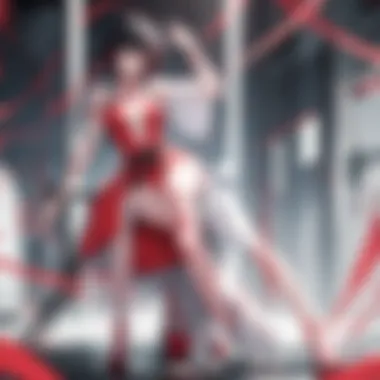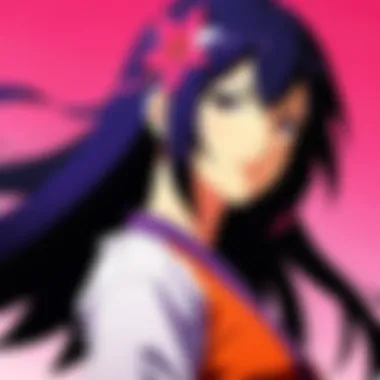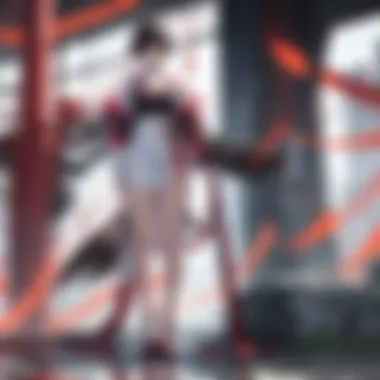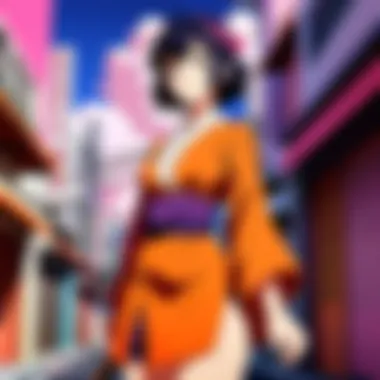Analyzing the English Dub of Bakemonogatari


Prologue to the Series
"Bakemonogatari", which translates to “Monster Story”, is a captivating anime that sits at the intersection of supernatural intrigue and character-driven narrative. Adapted from the light novel series by Nisio Isin, the anime first graced screens in 2009, marking its territory in the slice-of-life and mystery genres. Characters are rich with depth, and the storyline straddles the line between everyday life and the bizarre, rooted in Japanese folklore.
The series centers around Koyomi Araragi, a high school student who finds himself entangled with various oddities and girls afflicted by peculiar supernatural ailments. The intricate dialogues paired with surreal visual artistry capture the essence of modern anime in a way that resonates deeply with audiences. Its production by the renowned studio Shaft, known for their distinctive animation style, adds another layer of allure.
Upon its release, "Bakemonogatari" garnered acclaim not only for its engaging plot and character development but for its stylish presentation. Fans were captivated, paving the way for a cult following. The vibrant personalities and their struggles weave together a narrative that's not just entertaining but also thought-provoking, touching on themes of identity, trauma, and the nature of relationships.
Reception and Popularity
The reception of the series has been predominantly positive, praised for its unique storytelling approach. Critics and fans alike have hailed "Bakemonogatari" for pushing the boundaries of animation and narrative structure. Reviews often highlight its ability to blend humor with profound themes, drawing viewers into a contemplative viewing experience. It certainly sits high on the proverbial shelf of essential anime for not just entertainment seekers but for those yearning for rich narratives.
Moreover, "Bakemonogatari" has seen its influence spill beyond the screen with merchandise, adaptations, and discussions that reflect its impact. The series reflects a distinctive flavor of Japanese culture that invites viewers to explore deeper, poignantly inviting.
The unique localization process that the English dub undergoes becomes crucial in shaping the viewer's connection to the characters and themes, marking a significant transition from its original Japanese iteration.
Foreword to Bakemonogatari
The anime series Bakemonogatari, part of the larger Monogatari series, captivates audiences with its unique storytelling and distinct visual style. Encapsulated within a narrative that merges supernatural themes with the intricacies of adolescent relationships, it holds a crucial place in contemporary anime discourse. Understanding Bakemonogatari is not only about appreciating its artistic aesthetics but also its characterization, dialogues, and thematic explorations. In this section, we shed light on the series' significance, laying the groundwork for a deeper exploration of its English dub and how it reshapes the viewer's experience.
Overview of the Series
Bakemonogatari debuted in 2009, directed by Akiyuki Shinbo and produced by SHAFT. It stands out due to its blend of dialogue-heavy scenes and imaginative visuals, capturing the essence of its source material, which is a series of light novels by Nisio Isin. The narrative revolves around Koyomi Araragi, a high school student who encounters various oddities—creatures and phenomena rooted in Japanese folklore—that often manifest in the lives of those around him, especially his female friends.
The series explores deeper themes like trauma, identity, and the complexity of human emotions through these encounters. Unlike typical anime, it doesn't rely heavily on action or fast-paced scenes; instead, it encourages viewers to engage with its philosophical dialogues and character development. This approach invites a reflective viewing experience, engaging audiences not just with plot mechanics but with emotional and intellectual resonance.
The animation style is marked by vibrant colors and distinctive character designs that accentuate the psychological nuances of the story. The mastery of SHAFT in framing dynamic shots offers a visual spectacle that enhances the thematic depth of Bakemonogatari. In the context of anime, it broke new ground, inviting fans into an era where storytelling also involved intricate visual language.
Cultural Significance of Bakemonogatari
Bakemonogatari is more than an anime; it serves as a cultural artifact reflecting the complexities of modern Japanese society. Its representation of youth issues, such as existential dread and the pursuit of individuality, resonates beyond cultural borders, making it a significant subject of study for enthusiasts and academics alike. The way the series presents folklore, blending it with contemporary problems, offers insights into how traditional narratives can adapt to modern contexts.
The series also challenges conventional anime tropes. Traditionally, supernaturals beings are depicted more distanced from human lives; however, here, they are intricately linked with personal struggles. Each character's ordeal with their respective 'oddities' speaks to broader themes of mental health and societal expectations. This layered storytelling invites discussions on sensitive topics, offering a platform for fans to engage in meaningful conversations.
Moreover, Bakemonogatari's impact is evident in its fandom, where appreciation extends beyond just watching it. Fans dissect character arcs, explore philosophical undertones, and share their interpretations across platforms like Reddit and various anime forums. This active engagement creates a community of not just viewers, but thinkers who delve deeper into the manga and anime universe.
In exploring the Bakemonogatari dub, its essence becomes even clearer, as the localization process adds yet another layer to the intricate narrative tapestry. Understanding how the dub navigates cultural nuances will provide further depth to the viewing experience—transforming the original work into something uniquely accessible to a Western audience.
Understanding the Dubbing Process
The art of dubbing goes way beyond simply translating and voicing over the original dialogue. It’s a complex process that can significantly shape how a series is perceived by its audience. For Bakemonogatari, the importance of this process cannot be understated, as it plays a pivotal role in character interpretation, emotional resonance, and overall narrative delivery. This section aims to break down the essential elements of dubbing, focusing on how they impact an anime's reception and success.
The Role of Voice Actors
Voice actors are the unsung heroes of dubbing. They breathe life into characters through their performances. While watching Bakemonogatari, the distinctiveness of each character's voice contributes massively to their personalities and the viewers’ connection to them. An exemplary voice performance can evoke a wide range of emotions, making the audience laugh, cry, or feel a chill down their spine.
Take, for instance, the character of Araragi Koyomi. The choice of voice actor has implications beyond mere dialogue delivery. Through tonal variations and inflections, the actor portrays Araragi's internal struggles and complexities. Some notable voice talent includes Bryce Papenbrook, who encapsulates the emotional layers of Araragi brilliantly.
- Emotion and Tone: The ability to convey nuanced feelings can make or break a character in the English dub.
- Character Interpretation: Every voice actor brings a unique flair, turning the same lines into something entirely different through their interpretation.


Adaptation of Scripts
Script adaptation plays a central role in the dubbing process. The script has to not only reflect the original dialogue but also make sense in the new cultural context. This isn’t just a straightforward task of translation; it's more like a balancing act. Adaptation involves localization—fitting the script into a frame that resonates with the target audience while preserving the essence of the original.
For Bakemonogatari, the dialogue is rich in cultural references, wordplay, and idioms that may not translate neatly into English. Dubbing teams often need to come up with creative alternatives that capture the spirit without losing the character’s voice.
- Creative Liberties: Sometimes, a translation might take a more liberal approach, adjusting phrases to fit Western sensibilities or humor.
- Pacing and Timing: Dialogue adaptation needs to consider pacing, ensuring that it syncs expertly with the characters’ mouth movements on screen.
Cultural Localization Challenges
Navigating cultural localization challenges is like shooting fish in a barrel—if you don't know where to aim, it won't work. Dubbing Bakemonogatari includes the endeavor of making cultural references relevant to a Western audience. Some scenes harbor subtleties that are profoundly tied to Japanese cultural contexts. When these episodes are converted for English-speaking viewers, it's essential to highlight these nuances appropriately.
For instance, the reference to certain Japanese holidays, customs, or even casual social dynamics can be lost if not localized well. Dubbing teams face choices like deciding whether to retain certain phrases or phrases that are distinctly Japanese or alter them for relatability.
"Dubbing is as much about preserving the narrative's integrity as it is about ensuring audience relatability."
- Cultural Nuances: Being sensitive to cultural differences is crucial to maintain respect and authenticity.
- Audience Perception: If cultural elements are mishandled, this may lead to misunderstandings and disengagement.
Understanding the dubbing process, especially in a culturally rich series like Bakemonogatari, reveals the intricate web that connects voice acting, script adaptation, and cultural localization. These elements combined can elevate the viewing experience for Western audiences, adding layers to what is already a compelling narrative.
Analyzing the Bakemonogatari Dub
In any animated series, dubbing is like the unspoken linchpin that allows foreign audiences to connect with the story. When one dives into "Bakemonogatari," it’s not just about the visuals or the plot; it’s the vocal performances that breathe life into the characters. Thus, exploring the dub of this series becomes paramount to understanding how the layered narrative is accessible to English-speaking viewers. Ultimately, this section digs into elements that bolster the viewing experience while revealing the subtleties lost or altered in translation.
Character Voices and Performances
The voice actors play a pivotal role in delivering the essence of each character. In "Bakemonogatari," this becomes even more pronounced, considering how distinct each character's personality is, ranging from the sharp-tongued Hitagi Senjougahara to the whimsical Mayoi Hachikuji. Each performer is tasked with capturing not just the nuances of dialogue but also the emotional landscape.
For instance, Sayaka Ohara, voicing Hitagi, brings an edge that's both captivating and chilling, ensuring Hitagi’s sardonic wit strikes the right tone in the English version. It’s a balancing act, where subtleties in inflection and pace can either fortify or distort a character’s intended portrayal. The art of voice acting requires more than just delivering lines; it’s about evoking genuine reactions from the audience.
- Importance of voice matching: The alignment of tone with character traits can greatly enhance viewer engagement.
- Vocal differentiation: Unique voice profiles contribute to character distinctiveness, helping fans relate or connect with them on a deeper level.
Tone and Emotional Impact
The emotional fabric of "Bakemonogatari" is woven tightly with dialogue that is as poetic as it is impactful. The dub must traverse cultural boundaries while retaining the spirit of the original work. This task is no small feat. The tone established in the original Japanese dialogue set an emotional benchmark that the dubbed version must meet, if not exceed.
Throughout the series, the shifts from light-hearted banter to intense emotional exchanges showcase a spectrum that the dub must navigate. When Koyomi Araragi grapples with existential thoughts, the voice actor must convey a fragility that resonates. The emotional heft of scenes hinges on how effectively these performances echo the original's intent. The interplay between actors’ delivery and the dubbed dialogue reveals whether the emotional nuances land or fall flat.
"For the audience, it's essential to feel what the characters feel, and the voice actors bridge that gap."
Audience Reception and Critique
A significant aspect of dubbing involves the audience's perception. How viewers respond to the dub can often hinge on their preconceptions about dubs in general, and their attachment to the original. In online communities, notably on platforms like Reddit, discussions about the performances of various voice actors often surface. Some may find the English dub to offer fresh perspectives, while others argue it pales compared to the subtitled version.
- Critical feedback: Dubbing can lead to contrasting opinions among fans; some may favor the original due to cultural context.
- Community discussions: Online forums become a hotbed for sharing experiences and insights, helping newcomers to navigate the differing interpretations of the series.
Comparing Dub and Sub
When delving into the world of anime, the discussion often hinges on two modes of viewing: dubbed versions and subtitled content. This aspect is particularly crucial in the context of the Bakemonogatari experience. While the visuals and storytelling draw viewers in, how the dialogue is delivered—be it through voice acting or text translation—can heavily influence perception and emotional connection with the characters.
Differences in Experience


The way audiences experience Bakemonogatari can be quite distinct between the dub and sub formats. Dubbing offers a localized rendition that provides convenience for those who prefer not to read subtitles. For instance, the English voice actors aim to embody the essence of the original characters, bringing their own interpretations to the forefront. This can create a somewhat different atmosphere—one that might resonate more profoundly with viewers accustomed to English media. Conversely, watching with subtitles allows for a direct experience of the original dialogue, maintaining nuance that might get lost in translation. Often, fans argue that subtitled versions capture phrasing and cultural references that dubs might simplify or change, leading to a richer experience in understanding character intentions.
Subtitles vs. Dubbing Preferences
Choosing between subtitles and dubbing can depend heavily on personal preference. Some viewers lean toward subtitles because they appreciate the authenticity of the original voice performances. The subtle inflections and emotions conveyed by the Japanese voice actors contribute to a richer, more immersive experience. Yet, others might argue that dubs make Bakemonogatari more accessible, especially for newcomers who are still getting familiar with anime as a medium. They argue that having the story conveyed without needing to read can make it easier to follow the intricate plotlines and character dynamics, especially in a dialogue-heavy series like this. In many online communities, discussions often arise debating which format enhances the viewing experience, with passionate opinions often stacked on both sides.
Artistic Intent and Interpretation
Artistic intent plays a key role in the dub vs. sub debate. When adapting Bakemonogatari, the voice cast and production team grapple with translating not just the words but the emotion, context, and subtleties of the characters’ journeys. Dubbing can distort the original intent if liberties are taken too far, altering character personalities or story arcs in a way that doesn’t align with the creators’ vision.
However, a well-executed dub can bring a new dimension to a character, providing a different interpretation that some viewers may find appealing. For instance, the English voice actor might channel a particular tonal quality that groups the character into a relatable archetype for English-speaking audiences—making them more approachable. This dance between staying true to the original and making the content relatable is a delicate balancing act.
"Dubbing is as much an art as the original acting; it needs to stay true while making it resonate with a different audience."
While the discussion is often framed as a preference problem, it’s wise to recognize that both dubs and subs have their merits and challenges, each contributing uniquely to the revered legacy of Bakemonogatari. As fans continue to engage with both formats, the conversation around them evolves, pushing for deeper understanding and appreciation of adaptation in anime.
The Voice Cast Behind Bakemonogatari
The voice cast in any anime holds immense significance, and when it comes to Bakemonogatari, this is especially true. The character performances, infused with both emotion and nuance, often define the essence of the series itself. A great voice cast helps in underpinning the personalities of the characters, capturing their quirks, and amplifying the show's thematic depth. In the case of Bakemonogatari, the voice actors not only bring the characters to life but also connect with the audience on a deeper level, ensuring the series leaves a lasting impact.
Notable Performers and Their Roles
Diving into the notable performers, each brings unique flair to their roles.
- Hiroshi Kamiya lends his voice to Koyomi Araragi, embodying a blend of charm and vulnerability. His portrayal resonates with fans who appreciate the layered personality of the protagonist.
- Hochu Otsuka as Ononoki Yotsugi presents a distinct performance that balances deadpan humor and surprising emotional depth, showcasing the character's complexity.
- Maaya Sakamoto's role as Hitagi Senjougahara cannot be overstated; her delivery perfectly matches the character's sharp wit and secretive nature, adding considerable depth to the dialogue.
These performances, amidst others, collectively create a tapestry that enriches the viewing odyssey, immersing fans in the world established by Nisio Isin's novels.
Interviews with Voice Actors
In interviews, many voice actors express how they contextualize their characters within the broader narrative. For instance, Hiroshi Kamiya mentioned the challenges of infusing Koyomi with a mix of spontaneity and self-doubt. He explained, "It's like walking a tightrope; you want to maintain the character’s essence while also making it relatable to viewers, especially in such surreal conditions."
Furthermore, Maaya Sakamoto emphasized the significance of chemistry among the voice cast. "It isn’t just about individual performance; it's about how all characters interact. That connection elevates the series as a whole," she mentioned in one of her interviews. These insights provide a window into how nuanced the process of dubbing can be, illustrating that every line is carefully crafted for the emotional clarity it delivers.
Legacy of the Cast
As time passes, the voice cast of Bakemonogatari has established a significant legacy in the realm of anime. Many of the actors have gone on to become household names within the industry, with their performances in this anime remembered fondly. The portrayal of Koyomi, Hitagi, and other characters have become reference points for discussions regarding voice acting in contemporary anime.
Moreover, the success of the dub has influenced how upcoming voice actors approach their roles in similar works. It serves as an unspoken benchmark, demonstrating the intricate dance between voice performance, character development, and audience engagement.
This enduring legacy speaks to the heart of what makes Bakemonogatari resonate with its audience, and it will likely continue to inspire conversations and growth within the voice acting community for years to come.
In anime, the voice cast is not merely auxiliary; they are the soul that breathes life into every character, resonating with audiences and shaping perceptions long after the screen goes dark.
The Role of Music in the Dub
Music in an anime is often like the beating heart of a narrative. Especially in a series like Bakemonogatari, where the soundscape complements its unique storytelling style, music plays a pivotal role. The harmony and dissonance crafted through the soundtrack facilitate not just background ambiance, but actively enrich the viewing experience, underscoring emotional nuances and thematic complexities of the story.
Soundtrack Selection and Adaptation


The choice of music in the English dub of Bakemonogatari deserves a thorough examination. One of the standout features of this series is its ability to meld various musical influences, from jazz to pop. In the dub adaptation, this selection had to be meticulously crafted to resonate with English-speaking audiences without losing the series' cultural essence.
- Diverse Genres: The original Japanese soundtrack combined a myriad of genres. Here, dubbing directors needed to consider how each track translates emotionally while still holding true to the series' tone. For instance, a jazzy mood might lose its intended impact if replaced by a pop track that falls flat connotatively.
- Age of Characters: Notably, the ages of the characters and their backgrounds influence the musical choices as well. The character of Hitagi Senjougahara, for example, benefits tremendously from ethereal and haunting pieces, mirroring her complexity.
An essential factor in this adaptation lies in capturing the subtleties of instrumental choices that appear in the original score. The challenge for those involved with the dub rests in maintaining fidelity to the original while ensuring that the English version resonates effectively with its audience.
Impact on Viewing Experience
The influence of music extends beyond mere enjoyment; it is foundational to how audiences perceive Bakemonogatari’s narrative. When discussing how music shapes viewing experiences, consider the following:
- Emotional Resonance: Bakemonogatari delves into themes of personal struggle and existentialism, and the music enhances these dialogues. For instance, during poignant scenes, the carefully-curated score elevates the emotional weight—making the viewer feel the gravitas of the moment intensely.
- Cultural Context: As a fusion of Japanese culture and Western adaptation, the use of familiar musical elements helps bridge the cultural gap. This can soothe viewers, making it easier to engage with unfamiliar themes and characters.
"Music is a universal language that transcends barriers, yet it still must be translated when cultural contexts shift."
Critical Reception and Analysis
The critical reception and analysis of the Bakemonogatari dub hold weight in discussions about anime adaptation processes. It brings to light the complexities involved in portraying characters through voice and dialogue in a language different from the original. Critics and fans alike often grapple with how well the dub performers can convey intricate emotions and cultural references inherent in the source material. This section delves into the impact of critical reviews and fan community discussions, showcasing the unique reception this adaptation has received over the years.
Reviews from Critics
The response from critics surrounding the Bakemonogatari dub is a mixed bag reflecting diverse opinions. Some reviewers commend the vocal performances for their depth and alignment with the characters’ personalities, while others criticize certain choices made in translation and localization. Notably, the dub manages to maintain a certain rhythm and style that reminiscent of the original Japanese, but also takes creative liberties that don't always sit well with everyone.
An example is the portrayal of Araragi Koyomi, whose laid-back attitude and humor could have easily been lost in translation. Reviewers noted that the voice actor successfully captured his essence, making the character feel relatable to English-speaking audiences. However, the critics also pointed out that certain puns and cultural jokes fell flat due to differences in language nuances. This highlights an ongoing debate among anime fans about how to stay true to the original while making it digestible for new audiences.
"Translating humor and cultural references can be like fitting a square peg in a round hole; sometimes it just doesn't click."
On platforms such as reddit, critiques continue to evolve as fans watch the series over and over, sparking engaging debates between those who prefer the dub versus those who swear by the sub. Critics’ reviews serve not only as a barometer for quality but also as starting points for discussions on adaptation in general.
Fan Reactions and Online Communities
In the realm of fan reactions, the dub of Bakemonogatari has inspired a robust online community. Social media platforms and dedicated anime forums are rife with discussions about various aspects of the dub. Fans express their preferences, often leaning towards their nostalgic ties to the first version they watched, be it dub or sub. This serves to spotlight the subjective nature of dubbing, with opinions split down the middle.
Among cherished moments, fans particularly enjoy the vocal chemistry between Araragi and Shinobu, voiced in English with a certain playful tension that speaks volumes to their complicated relationship. Many fans have taken to mediums like facebook to share memes or clips, often poking fun at weird translation moments or celebrating standout voice performances.
Communities on platforms like reddit host rich discussions, where meme-laden posts and serious analyses can coexist. Users often share their thoughts about the voice actors, sometimes debating who did a better job portraying integral character traits. This exchange of ideas can be insightful, revealing the layers of interpretation that come from listening to the dialogue versus reading subtitles.
Fans have also highlighted the importance of community in shaping how the dub is perceived. Live watch parties of Bakemonogatari often feature lively commentary, showcasing a shared experience that elevates the show beyond just a viewing, creating bonds over beloved characters and memorable lines.
Through the lens of both critics and fans, it becomes clear that the reception of the Bakemonogatari dub is about more than just words spoken on screen; it's an ongoing conversation about art, culture, and the nuances of storytelling that travels across languages.
Finale
The conclusion of this analysis reflects the intricate weaving done throughout the English dub of 'Bakemonogatari.' The experience of watching this anime in its dubbed form goes beyond mere voice work; it's a journey that taps into the heart of character nuances, cultural contexts, and audience perceptions. The significance of this exploration lies in a few specific elements.
Summarizing the Bakemonogatari Dub Experience
When pondering the dub of 'Bakemonogatari,' one must first navigate through the essence of character voices. Each voice actor brings their own flavor, adding richness that the original Japanese audio conveys sometimes differently. Adaptations can shift meanings based on vocal delivery. For instance, consider the lead character Koyomi Araragi. The English voice captures not only his wit but also his underlying vulnerabilities, possibly resonating more with Western audiences.
Another pillar of this experience is the choice of localization. Culturally relevant humor or phrases can sometimes take a hard left turn in translation. Prospective fans may find their perceptions altered by how these elements are adapted for the West. Moreover, the emotional heft of scenes can feel profoundly different, depending on the voice and inflection given during pivotal moments. This makes the viewing experience a unique tapestry, crafted from both original writing and dub adaptations.
The Future of Dubs in Anime
Contemplating the future of dubs in anime opens up a broader discussion about the industry's direction. As technology progresses, dubs could benefit from more sophisticated tools that help capture the emotional nuance of performances. Innovations in AI and voice modulation might present opportunities for actors to deliver even more authentic takes that resonate with fans worldwide.
In addition, the continued globalization of anime means that more audiences are clamoring for quality dubs. As markets expand, localization teams are likely to become more diverse, bringing a wider array of perspectives into the adaptation process. Future dubs will likely reflect these various cultural lenses, enriching the experience for viewers.
Overall, the future seems bright for dubbing in anime, with advancements paving the way for deeper emotional connections and widespread accessibility. The success of projects like the 'Bakemonogatari' dub sets a credible precedent for what's to come.















